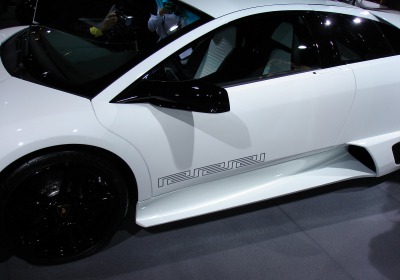Design Essay: The two-tone selector of style
Wed, 15 Nov 2006Not since the heady days of rude boy rule has two-tone black and white made such a comeback. The first showing was at the winter 2004 fashion catwalks, which then reached the stores in spring 2005. This trend was swiftly followed and endorsed by the furniture and product designers that showed their wares at the spring 2005 Milan Furniture Fair. By spring 2006, from every magazine to every high street store was awash with black crystal chandeliers and candelabras, to black and white floral prints for sofas...and so it goes - fashion, furniture and, last but not least, automotive.
To be fair, gaps are closing between disciplines. This was especially apparent when Lamborghini spearheaded an awe-inspiring line-up of pearl white tri-coat painted show cars, at Geneva two years ago. They flew in the face of the current anti-mantra of 'we are too cool for white': only true trend-setters have the nerve to oppose current trends, to put a different spin on things governed passe or distasteful, and thus create their own following. People forget too easily the magnificent eighties solid white Porsche 911 Carrera with black split-rim wheels and think instead of eighties-white Vauxhall Vectra Police cars and dodgy holiday taxis.
Tri-coats and pearls have given white a new lease of life, and even the forgotten simplicity of a solid white has captured the imagination of designers as seen at the Paris show this year on both the new Audi TT and the BMW Z roadsters.
Perhaps Lamborghini's insight was not a coincidence, but the result of working with leading Italian fashion house Versace. Shown at the Paris Motor Show, the Gianni Versace addition had a fresh take: the solid white exterior with black wheels and side mirrors gave a Star Wars stormtrooper-like impression. Versace's signature graphic was detailed in black on a solid white base on the two front doors and echoed again as a quilted, stitched detail on the white leather seat centres and black lower IP. The applique of carbon fibre on the centre console and instrument binnacle was, perhaps, a little excessive, though possibly a fitting style for the market to which it is aimed.
The second Lamborghini in the line-up reversed the combination, having an all black exterior with a black and ivory leather interior: the white leather had black stitched quilting for the door panels and seating.
The exterior of this vehicle was striking. The black deep gloss body panels juxtaposed a burnished satin black finish on the front hood side panels, roof and side backs. This combination, together with satin black wheel centres, proved an awesome new look.
Black and white was everywhere in Paris, from the showing of the new Audi TT [again shown in solid white paint with black trim] to Fiat models dressed like Barbarella to the black and white twelve-metre 'football' table at Fiat.
BMW were not to be left out: although the stand resembled a white perspex beauty counter in a department store, their series of white solid exteriors with black leather interiors jumped out against the black carpeted flooring.
BMW's Individual range displayed a BMW 730Ld with a white pearl tri-coat exterior complemented by piano black detailing around the centre edging of the wing mirrors and sill finishers. This was then translated to a very sophisticated black and white theme within the cabin.
BMW, known in the past for its very smooth Napa leather, seem to be experimenting beyond their usual perimeters, with the use of more natural full grain leather. The upper IP and door capping were in black, while a piano black centre panel swept across the IP dividing the black from the ivory leather lower. The steering wheel rim - in black - encased an Ivory 10mm centre rim, coordinated well with the contrasting white piping detail on the black carpets.
The top stitching on the seating stood out: a coarse black thread against Ivory leather. This was not conventional stitching, having a broken running line, it looked more like a tacking stitch on a gentleman's suit lapel - a more 'individual' stitch in time.
Sadly, the quality of the trimming was poor, especially notable around the door arms where there was puckering and pulling around corners and the trim of the seats - where seams were wrongly placed - exacerbated the problem. A real shame on what was, on the whole, a sophisticated well thought-out look.
By Sarah Maynard

